I have been creating a Sports Standings Dashboard that utilizes the ESPN REST interfaces as well and several sensors to deliver a consolidated dashboard for Home Assistant. It is a mix of REST sensors and templates sensors based on thse REST sensors to display standings for NHL, MLB, NFL and NBA sports. Of course you could change and extend to sports that you target if you like.
It has grown to the point where others should take a look and give feedback.
The full solution is posted here:
It has both Standings as well as PRE, IN and POST game statistics through the excellent Teamtracker integration and card.
From the Readme:
Sport Standings and Scores
This project has Sports Standings and Scores Sensors and Dashboard for Home Assistant. It contains NHL, NFL, MLB and NBA standings as well as pre-game, in-game and post-game statistics. It makes use of the ESPN APIs as well as the great Teamtracker Home Assistant App and Card.
Final Result
I always like to give you a glance at what you are building first. This helps you to understand the components and what goes into the solution. What we are building is shown here in the following images:
NHL Standings by Division
MLB Live Games
There are several components in this interface. Across the top it uses tabs to allow selection of what you want to see:
- Select the Sport (NHL, MLB, NFL or NBA)
- Standings has Divisonal, Conference and Overall standings for each sport
- Note: the current view also has Playoff/Wildcard placeholder yet to be done
- Each sport has post-game, in-game and pre-game display
Prerequisites
As for the GUI, there are several custom cards used. These include:
You also would need the Teamtracker integration for the game-based statistics. If you want the solution to work as is, you will need to be sure you have these installed and working in your Lovelace configuration.
Sensors
There are several sensors. The main sensors can be broken down into two types. The first is a single sensor for every sport that uses REST. These are in the GITHUB sensor.yaml file. One example is:
##
## NFL Standings
##
- platform: rest
scan_interval: 36000
name: NFL Standings
unique_id: sensor.nfl_standings
resource: https://site.web.api.espn.com/apis/v2/sports/football/nfl/standings?seasontype=2&type=0&level=3
value_template: "{{ now() }}"
json_attributes:
- children
In these REST sensors, it gets the data from the ESPN API using:
- seasontype = 2 (regular season)
- type = 0 (full stats)
- level = 3 (full/conference/division)
The other sensors in sensor.yaml are all teamtracker sensors for every team in all the sports. A short (snipped) example is like this:
##
## NFL Teams
##
- platform: teamtracker
league_id: NFL
team_id: DET
name: Detroit Lions
- platform: teamtracker
league_id: NFL
team_id: GB
name: Green Bay
- platform: teamtracker
league_id: NFL
team_id: CHI
name: Chicago Bears
- platform: teamtracker
league_id: NFL
team_id: MIN
name: Minnesota Vikings
- platform: teamtracker
league_id: NFL
team_id: BUF
name: Buffalo Bills
- platform: teamtracker
league_id: NFL
team_id: MIA
name: Miami Dolphins
The sensor.yaml attached has teamtracker sensors to every team in all those sports.
As a side note, I made these but I not type in every team. I use a tool to go JSON to XML using the JSON output from the standings file. The repository includes an XSL that can build the set based on the sensor for a sport. And yes, I used XML and XSL … because that is what I am familar with and this is a one off.
In order to get standings for all the divisions, I implemented template sensors for all of them. These are included in template.yaml in GITHUB. A short sample is like this for the NHL:
###
### NHL Divisions
###
- name: NHL East Atlantic
unique_id: sensor.nhl_east_atlantic
state: "{{ now() }}"
attributes:
entries: "{{ state_attr('sensor.nhl_standings','children')[0]['children'][0]['standings']['entries'] }}"
- name: NHL East Metropolitan
unique_id: sensor.nhl_east_metropolitan
state: "{{ now() }}"
attributes:
entries: "{{ state_attr('sensor.nhl_standings','children')[0]['children'][1]['standings']['entries'] }}"
- name: NHL West Central
unique_id: sensor.nhl_west_central
state: "{{ now() }}"
attributes:
entries: "{{ state_attr('sensor.nhl_standings','children')[1]['children'][0]['standings']['entries'] }}"
- name: NHL West Pacific
unique_id: sensor.nhl_west_pacific
state: "{{ now() }}"
attributes:
entries: "{{ state_attr('sensor.nhl_standings','children')[1]['children'][1]['standings']['entries'] }}"
The Dashboard
The complete dashboard is contained in dashboard.yaml. You can examine that and make changes you may want. It makes extensive use of decluttering to templatize things and make it easier and much shorter to write. I think I could go deeper here, but for now it has one template per sport (as the columns are different) and one for game stats. It uses flex-table to show standings. There is a help_template in a .txt file that can help you identify the fields that contain the columns you wish to show in standings.
There are a few nice things done with card-mod to implement nicer tabs, colorize active tabs and provide scrolling tables horizontally on smaller displays. Although I will say that I designed this for wall pads in the house with large screens, I would likely change things if I ever implemented it to target phone devices.
A lot of background information can be found here:
Update 3/13/2023:
Since the NHL started to return “CLINCH” indicators for some teams there are some code changes to handle this. I eliminated SEED and put in CLINCH indicator and changed to use abbreviation lookup instead of positional lookup because the positions would be different for teams as they clinch or are eliminated from playoff contention. The new code is posted in “dashboard.yaml”















